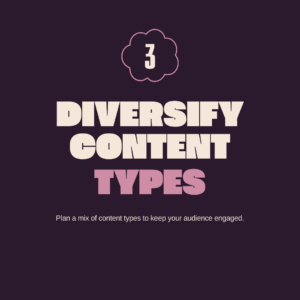A content calendar serves as the heartbeat of your digital presence, providing a structured plan for the creation, publication, and distribution of your content on social media. Think of it as a dynamic blueprint that guides your brand’s storytelling efforts across various online channels. Creating a content calendar is crucial for a successful content marketing strategy and it is important for everyone to work together when creating this calendar. While a content calendar provides structure, it’s not rigid. It’s designed to be adaptable. We can respond to real-time events, industry trends, and audience feedback. This flexibility ensures that your brand remains relevant and responsive in a dynamic digital landscape.
Here are five tips to help you put together a content calendar for 2024 with your marketing team:
-
1. Align with Business Goals and Events

Start by understanding the overarching goals of your marketing agency and your business goals for the year 2024. Identify key business milestones, product launches, and events that are planned internally that need to be shared with your marketing team. Create thematic content around major initiatives, ensuring that your content supports and enhances the overall marketing objectives.
The marketing team should also consider which social media channels are best for each goal and event. LinkedIn is different from Facebook and maybe a video needs to be created for Instagram and YouTube versus just images. Discussing the rollouts of these goals and events can help both teams plan for great coverage.
-
 2. Consider Seasonality, Trends and Business Specific Dates
2. Consider Seasonality, Trends and Business Specific Dates
Take into account the seasonality of your industry and the target audience’s behavior throughout the year. Certain times may be more opportune for specific types of content or promotions.
Additionally, keep an eye on industry trends and incorporate them into your content calendar. This will help your content stay relevant and engage with your audience’s current interests.
Followers love to engage with your content when they see the people running the show. Share employee birthdays, promotions, good news, business anniversaries, and so on. These posts are just as important as anything else.
-
3. Diversify Content Types

Plan a mix of content types to keep your audience engaged. This can include blog posts, videos, infographics, webinars, podcasts, and more. Experiment with different content formats and distribution channels to see what resonates best with your audience. This diversity not only keeps your strategy fresh but also accommodates different preferences and consumption habits. And don’t forget to re-use the content that you have, just in a different way. Blog posts are a great example of a large chunk of information that can be disseminated multiple times in multiple ways.
-
 4. Establish a Consistent Posting Schedule
4. Establish a Consistent Posting Schedule
Consistency is key in content marketing. Establish a regular posting schedule that aligns with your audience’s behavior. This could be daily, weekly, or bi-weekly, depending on your resources and the nature of your content.
Your marketing team can use scheduling tools to plan and automate posts, but remain flexible to capitalize on real-time opportunities or address emerging trends. Sharing these planned posts with your team can help you to see what is coming up in the schedule and if anything needs updated, moved or pushed in a different direction.
-
5. Integrate User-Generated Content and Feedback

Encourage user-generated content (UGC) to foster community engagement. Plan campaigns or activities that involve your audience in creating content, whether it’s through contests, challenges, or sharing their experiences. Monitor audience feedback and adjust your content strategy accordingly. This could involve addressing common questions, concerns, or interests expressed by your audience. Actively engage with your community to build a more dynamic and responsive content plan.
The Bottom Line
Remember to regularly evaluate the performance of your content and adjust your strategy as needed. Analytics and feedback should inform your ongoing content calendar refinement throughout the year. Through analytics and performance metrics, we can track how your content is resonating with your audience, what they like the most and don’t really seem to care for. This data-driven approach allows us to iterate and refine our strategy, ensuring continuous improvement.


